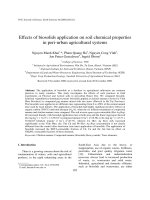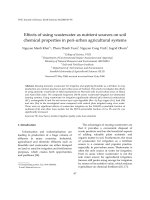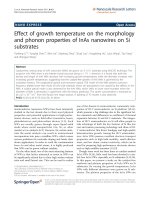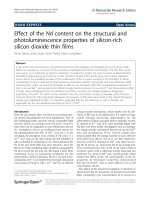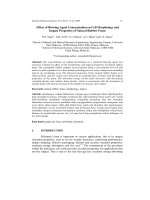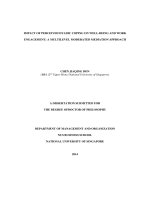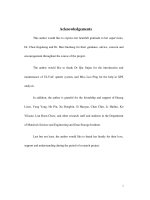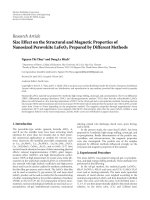Effect of climate change on soil chemical and biological properties - A review
Bạn đang xem bản rút gọn của tài liệu. Xem và tải ngay bản đầy đủ của tài liệu tại đây (314.82 KB, 11 trang )
Int.J.Curr.Microbiol.App.Sci (2019) 8(2): 1502-1512
International Journal of Current Microbiology and Applied Sciences
ISSN: 2319-7706 Volume 8 Number 02 (2019)
Journal homepage:
Review Article
/>
Effect of Climate Change on Soil Chemical and
Biological Properties-A Review
M.C. Anjali1* and B.C. Dhananjaya2
Department of Soil Science and Agricultural Chemistry, UAHS, Shivamogga-577225, India
*Corresponding author
ABSTRACT
Keywords
Climate, Soil
Properties, CO2
Article Info
Accepted:
12 January 2019
Available Online:
10 February 2019
Climate change influences composite set of measurable physical, chemical and biological
soil properties attributes which relate to functional soil processes. Climate change impacts
soil chemical, physical and biological functions through a range of predicted global change
drivers such as rising atmospheric carbon dioxide (CO 2) levels, elevated temperature,
altered precipitation (rainfall) and atmospheric nitrogen (N) deposition (French et al.,
2009). The exact direction and magnitude of these impacts will be dependent on the
amount of change in atmospheric gases, temperature, and precipitation amounts and
patterns. Many studies have progressed our understanding of relationships between
particular soil properties and climate change drivers, e.g. responses to temperature, CO 2 or
rainfall. The complexity and interdependence of many of the climate change drivers
influence soil microbial properties like microbial biomass and biomass diversity, rate of
organic matter decomposition, C and N cycles, chemical properties of soil like pH, EC,
nutrient availability and physical properties like porosity, aggregate stability, soil erosion,
etc.
Introduction
The
most
recent
report
of
the
Intergovernmental Panel on Climate Change
(IPCC) indicates that the average global
temperature will probably rise between 1.1
and 6.4°C by 2090 – 2099, as compared to
1980–1999 temperatures, with the most likely
rise being between 1.8 and 4.0°C (IPCC,
2007). The idea that the Earth’s climate is
changing is now almost universally accepted
in the scientific community (Cooney, 2010;
Corfee- Morlot et al., 2007), and even many
scientists who dispute that climate change is
anthropogenic are in agreement that it is
happening (i.e., Kutílek, 2011; Carter, 2007;
Bluemle et al., 1999). Therefore, even if we
can’t agree on why climate change is
happening, it should be possible to agree that
it is happening, and with climate change
happening, there will be effects on the
environment, including the soil. In the last
century considerable changes took place in
the gas composition of the atmosphere due to
natural processes and human activities, such
as
increasing
energy
consumption,
industrialization, and intensive agriculture,
urban and rural development. This has led to a
1502
Int.J.Curr.Microbiol.App.Sci (2019) 8(2): 1502-1512
rise in global temperature and high spatial and
temporal variability. The changing the
temperature regime would result in
considerable changes in the precipitation
pattern. Soils are intricately linked to the
atmospheric–climate system through the
carbon, nitrogen, and hydrologic cycles.
Factors of soil formation
Soil is a naturally occurring body, that has
been evolved owing to combined influence of
climate and organisms acting on parent
material as conditioned by topography over a
period of time. Living things: Plant roots
physically break rocks into small pieces;
lichen dissolves rock; burrowing animals mix
the soil and help aeration. Climate: heat and
water accelerate chemical changes (so moist,
temperate areas have different soils than arid,
tropical, or polar areas). Topography: Loose
soil stays in place in flat areas, allowing more
thorough physical and chemical alteration of
its grains. On steep slopes, the soil moves
downhill before complete alteration can
occur. Parent material: Chemical changes
during soil formation depend on what
minerals and rocks are present. Ex: Calciumrich soils generally form from calcium-rich
rocks (like limestone) but not from calciumpoor rocks like granite. Time: When bedrock
is exposed at the surface, chemical, biologic,
and physical processes combine to produce a
thin soil layer.
Over time, the processes extend vertically
downward, developing soil horizons whose
position and thickness change over time.
Climate is the average weather at a given
point and time of year over a long period. The
average weather includes all the associated
features such as temperature, wind patterns
and precipitation. Any change in climate over
time, whether due to natural variability or as a
result of human activity is called as climate
change. Climate change and its hydrological
consequences may result in the significant
Modification of soil conditions. The impact
analysis of potential future changes is Rather
difficult, due to the uncertainties in the
forecast of global and long-term Temperature
and precipitation patterns (including their
spatial and temporal variability) Combined
here with the changing hydrological cycle and
the complex and integrated Influences of
natural vegetation and land use pattern (partly
due to the changes in the Socio-economic
conditions). Consequently the long-term and
global ‘soil change Prognosis’ can only be a
rather
rough,
sometimes
imaginative
estimation and allows only for the drawing of
general conclusions. In the natural soil
formation processes the pedogenic inertia will
cause different Time-lags and response rates
for different soil types developed in various
regions of our Globe (Scharpenseel et al.,
1990; Lal et al., 1994; Rounsevell and
Loveland, 1994).
Drivers of climate change
Climate change impacts soil chemical,
physical and biological functions through a
range of predicted global change drivers such
as CO2, N deposition, Temperature and
Rainfall.
The CO2 concentration reached a level of 386
ppm in 2009 and increased further to 389
ppm. This is an increase of about 110 ppm
(+38%) compared to the pre-industrial levels
(i.e.
before
1750)
(NOAA,
2011).
Atmospheric CO2 concentration increased
globally by nearly 30%, Temperature by
approximately 0.6°C, and these trends are
projected to continue more rapidly. The
suggested increase in mean annual surface
temperature of 2-7°C by 2100 is the largest
change globally. The Nitrous oxide (N2O)
concentration in 2009 was 322 ppm, up 0.6
ppb from the year before (Encyclopedia
Britannica). The atmospheric carbon dioxide
1503
Int.J.Curr.Microbiol.App.Sci (2019) 8(2): 1502-1512
increased in 2012 at a faster rate than the
average over the past 10 year because of a
combination of continuing growth of
emissions and a decreasing in land carbon
sinks. The carbon dioxide emissions recorded
high in 2012, the emission trend of carbon
dioxide by different countries as followed the
decreasing order: China>Japan>Middle East
>India>European Union>United States. China
is the major contributor for carbon dioxide
emission. India contributes about 7.7 percent
to the total world emission. The carbon
dioxide released to the atmosphere is more
compare to the carbon sequenced in soil due
to human activity and natural processes. The
N2O enters to the atmosphere through Emitted
during agricultural and industrial activities, as
well as during burning of fossil fuels and
solid waste. The nitrous oxide concentration
in the atmosphere increases 19% above the
pre-industrial level. Emission trend of nitrous
oxide by different sources as followed the
decreasing order: soil>agriculture>rivers
>oceans>fossil
fuel=
biomass>human
activity. Soil is the major contributor for
nitrous oxide emission. Soils contribute about
6.6 percent to the total emission of nitrous
oxide (world energy outlook special report
2012.
According to the Intergovernmental Panel on
Climate Change, global temperatures are
expected to increase 1.1 to 6.4°C during the
21st century. When the green houses gasses
increases in the atmosphere that leads to
increases the earth temperature. Some of the
infrared radiation passes through the
atmosphere and some of the radiation is
absorbed and re emitted by the green house
gasses molecule. The effect of this warm up
the earth surface and lower atmosphere. As
average global temperatures rise, the warmer
atmosphere can also hold more moisture,
about 4 percent more per degree Fahrenheit
temperature increase. Thus, when storms
occur there is more water vapor available in
the atmosphere to fall as rain, snow or hail.
Worldwide, water vapor over oceans has
increased by about 4 percent since 1970
according to the 2007 U.N. Intergovernmental
Panel on Climate Change report.
Why should we be interested in climate
change?
Climate determines the type and location of
human managed ecosystems, such as
agricultural farmlands. Climate affects the
weathering of rock, the type of soil that
forms, and the rate of soil formation. Climate
helps to determine the quantity and quality of
water available for human use. Climate
determines the severity of droughts, storms,
and floods. Climate largely determines the
nature and locations of biomes (major
terrestrial ecosystems, defined based on their
plant communities).
The climate change affect the net primary
productivity in interactive effect with land
management practices by affecting soil
processes like physical, chemical and
biological processes (Adapted from Dalal and
Moloney, 2000; Gregorich et al., 1994;
Haynes, 2008; Idowu et al., 2009; Kinyangi
2007; Reynolds et al., 2009; Stenberg, 1999).
Climate change influences composite set of
measurable physical, chemical and biological
soil properties attributes which relate to
functional soil processes. By considering
know I interested to know the impact of
climate change on chemical properties of soil
Soil chemical properties affected by the
climate change
Soil pH, Rate of acidification or alkalization,
Electrical conductivity, Leachable salts
adsorption, CEC, Plant available N,P,K,S.
etc., are affected by climate change
1504
Int.J.Curr.Microbiol.App.Sci (2019) 8(2): 1502-1512
Schematic representation of the potential links between climate change, land use and
management change, and soil health indicators (modified from Dalal and Moloney, 2000;
French et al., 2009; Karlen et al., 2003; Nuttall, 2007)
Soil health indicators and relations to processes and functions under projected climate
change scenarios
Soil health indicators
PHYSICAL
Soil structure
Porosity
Soil processes affected
Infiltration
Bulk density
Aggregate stability, organic matter turnover
Air capacity, plant available water capacity, relative yield
capacity
Soil water availability and movement.
Soil structural condition, compaction
Soil depth and rooting
plant available water capacity, sub soil salinity.
Soil plant available water and distribution
Field capacity, permanent wilting point, macro pores
flow, texture.
soil water and nutrient movement, soil stabilization, C
and N fixation
Soil protective cover
CHEMICAL AND BIOLOGICAL
pH
Biological and chemical activity thresholds
EC
Plant and microbial activity thresholds.
Plant available N, P,K.
Soil organic matter
light fraction or Macro-organic matter
Mineralisable C and N
Plant available nutrients and potential for loss
Plant residue decomposition, organic matter storage and
quality, macro aggregate formation, metabolic activity of
soil organisms, net inorganic N flux from mineralization
and immobilization
Soil total C and N
Sol respiration
Microbial biomass C and N
Microbial quotients
Microbial diversity
C and N mass and balance.
Microbial activity
Microbial activity
Substrate use efficiency
Nutrient cycling and availability
1505
Int.J.Curr.Microbiol.App.Sci (2019) 8(2): 1502-1512
Soil pH
Brinkman and Sombroek (1999) suggested
that most soils would not be subjected to
rapid pH changes resulting from drivers of
climate change such as elevated temperatures,
CO2 fertilization, variable precipitation and
atmospheric N deposition. Similar findings
are founded by DeVries and Breeuwsma
(1987); McCarty et al., (2001). Drivers of
climate change will affect OM status, C &
nutrient cycling, plant available water &
hence plant productivity, which in turn will
affect soil pH (Reth et al., 2005).
They sampled at locations arrayed in an
elevation transect up the slope of Rattlesnake
mountain (1093 m) located on the ALE(Arid
Land Ecology reserve). Twenty-five sites
were identified for sampling starting at an
elevation of 228 m and continuing every 25 m
to a maximum elevation of 844 m. Average
precipitation increases from 180 mm at the
lowest elevation to 270 mm at the 844 m
elevation site. The Soil pH decreased with
increasing elevation, the trends of decreasing
soil pH could be due to increased leaching of
basic cations in the higher elevations from
greater precipitation and from increased
nitrification. Therefore the pH of soil
decreases when move from lower elevation to
higher elevation as shown in the Figure 1
(Smith et al., 2002).
reserve. Twenty-five sites were identified for
sampling starting at an elevation of 228 m and
continuing every 25 m to a maximum
elevation of 844 m. Average precipitation
increases from 180 mm at the lowest
elevation to 270 mm at the 844 m elevation
site. They reported that soil EC increased with
elevation with the top two sites significantly
greater than the lower sites The increase in
EC with elevation would seem to contradict
the hypothesis that the leaching of bases is
causing the lower soil pH values with
increasing elevation. However, in both the
grass and crust soil there was a significant
amount of nitrate in the higher elevations
which could contribute to the increase in EC
over the 500 m elevation transect as could
greater H+ ion concentrations from the lower
pH as shown in Figure 2 (Smith et al., 2002).
CEC
CEC of coarse-textured soils and low-activity
clay soils is attributed to that of SOM, the
increasing decomposition and loss of SOM
due to elevated temperatures may lead to the
loss of CEC of these soils (Davidson and
Janssens, 2006). Low CEC of soil may result
in increased leaching of base cations in
response to high and intense rainfall events,
thus transporting alkalinity from soil to
waterways.
Acidification
EC
Pariente (2001) examined the dynamics of
soluble salts concentration in soils from four
climatic regions (Mediterranean, semi-arid,
mildly arid and arid) and found a non-linear
relationship between the soluble salts content
and rainfall, with sites that received <200 mm
rainfall contained significantly high soluble
contents and vice versa. They sampled at
locations arrayed in an elevation transect up
the slope of Rattlesnake mountain (1093 m)
located on the ALE(Arid Land Ecology
Decreasing
precipitation
may
reduce
downward filtration and leaching. Climate
determines the dominant vegetation types,
their productivity, the decomposition rate of
their litter deposits, and influences soil
reaction in this indirect way.
Salinization/Sodification
A consequence of the expected global
‘warming’ is the rise of eustatic sea level:
increase of inundated territories (especially in
1506
Int.J.Curr.Microbiol.App.Sci (2019) 8(2): 1502-1512
the densely populated delta regions and river
valleys), and the areas under the influence of
sea water intrusion.
Plant available nutrients
Nutrient cycling, especially N, is intimately
linked with soil organic C cycling and hence
drivers of climate change such as elevated
temperatures, variable precipitation and
atmospheric N deposition are likely to impact
on N cycling and possibly the cycling of other
plant available nutrients such as phosphorus
and sulphur, etc. (Weil and Magdoff, 2004,
Kumar and Swarup, 2012). The soil N in the
surface 5 cm of the forest soil increased
linearly during 5 years of exposure to elevated
CO2 as shown in the Figure 3. While N in the
ambient plots remained relatively constant,
consistent with vegetative effects on soil
formation, increases in soil N storage,
particularly in forests, are more likely to
occur near the surface, where inputs from
roots and above ground litter are greatest
(Jastrow et al., 2005).
The positive feedbacks amplify system
responses to changes in constraints. Thus,
responses to boreal and temperate forests to
carbon dioxide induced climate change may
depend on the balance between changes in
hydrological cycle that constrain the forest
response and the positive feedbacks between
the carbon and nitrogen cycles that amplify
this response. If the vegetation response to
drought decreases nitrogen availability, then
the positive feedback between the carbon and
the nitrogen cycles weakens, resulting in a
decline in productivity. Conversely, if climate
change alters forest composition, thus
enhancing growth of species which can
further enhance soil nitrogen availability
through the chemistry of their litter, then the
same positive feedback results in an increased
productivity. Therefore, interactions between
vegetation
and water and nitrogen
availabilities may produce a bifurcation in the
forest ecosystem response that is increased
productivity where soil water is not limiting
and nitrogen availability is enhanced,
decreased productivity where water and
nitrogen become more limiting. Forest
responses to climate change are as sensitive to
the indirect effects of climate and vegetation
on soil properties as they are to direct effects
of temperature on tree growth. The
heterogeneity of landscape, particularly the
distribution of various soils, becomes an
important factor determining forest responses
to climate change, because these bifurcations
can occur within as well between, biomes
(Paster and Post, 1988).
Biological Properties Affected by Climate
Change
While the chemistry (and physics) of the soil
system provides the context... it is the soil
biota which is adaptive to changes in
environmental circumstances” (Kibblewhite
et al., 2008).
Soil microbial biomass
Soil microbial biomass has been shown to be
responsive to short term environmental
changes (Haynes, 2008 and Pregitzer et al.,
2008). Recent studies revealing significant
decline in the soil microbial biomass during
long-term simulated climatic warming
experiments (Rinnan et al., 2007)
The relative abundance of bacterial phyla was
clearly impacted by the precipitation
treatment, which led to shifts in the relative
abundance Proteobacteria and Acidobacteria.
The other two factors, carbon dioxide and
temperature, did not have a major impact on
the distribution of these groups. The relative
abundance of Proteobacteria was greater in
the wet relative to the dry treatments, whereas
Acidobacteria abundance was greater in dry
1507
Int.J.Curr.Microbiol.App.Sci (2019) 8(2): 1502-1512
treatment as shown in Figure 4. Because
Acidobacteria is ubiquitous phylum in soil
they required aerobic condition for their
metabolism,
Proteobacteria
required
anaerobic condition for their metabolism
(Castro et al., 2009).
Soil respiration
Soil respiration, particularly its temperature
response is widely acknowledged to be a
critical link between climate change and the
global C cycle (Wixon and Balser, 2009).
Studies have also shown that soil respiration
is relatively responsive to changes in the
seasonal timing of rainfall, which is predicted
to change according to global and regional
climate models (Chou et al., 2008)
This research was conducted by FACTS-II
FACE project is located near Rhinelander,
WI, USA (45°40.5′N, 89°37.5′E, 490 m
elevation). The experiment is a randomized
complete block design with three replicates of
factorial CO2 (ambient and elevated to 560 μl
l−1) and O3 (ambient and elevated to 50 nl
l−1) treatments. Seasonal soil respiration for
Enzyme
α-1,4-glucosidase
β-1,4-glucosidase
Alk phosphatase
N-acetylglucosaminidase
2005, 2006 and 2007 was significantly greater
under +CO2, but was not significantly
affected by +O3 (Fig. 5). The +CO2 +O3
treatment tended to have the greatest values
for seasonal soil respiration across all
community types (5–10% greater than +CO2),
but values for the +CO2 +O3 treatment were
not significantly greater than those for +CO2
alone. Across treatments, seasonal soil
respiration was significantly greater in the
aspen community than for the birch/aspen and
maple/aspen communities during 2005 and
2006, but not in 2007 (Pregitzer et al., 2008).
Enzyme activity
Soil enzyme activities show rapid response to
changes in soil management (Aon et al.,
2001; Ruiz et al., 2009). Studies of individual
enzyme activities report strong temporal &
spatial variability, often leading to conflicting
results (Aon et al., 2001; Ruiz et al., 2009).
Dorodnikov et al., (2009) showed that by
altering the quantity and quality of below
ground C input by plants, elevated CO2 may
stimulate microbial enzyme activities (Castor
et al., 2009).
Enzyme activities and elevated CO2
Ambient CO2 (µmol kg-1h-1)
Elevated CO2 (µmol kg-1h-1)
1.0 ± 0.9
2.1 ± 0.8
145.7 ± 18.6
129.5 ± 7.8
332.4 ± 6.3
234.8 ± 7.6
48.0 ± 2.1
6.7
Potentially mineralizable C and N
These processes are closely connected with
the soil moisture regime a and with the abiotic
& biotic transformation phenomena (fixation,
immobilization / release, mobilization;
changes in solubility and redox status, etc.).
High precipitation increases leaching,
filtration
loss
(potential
groundwater
pollution) and reductive processes. Low
precipitation (dry conditions) may reduce the
solubility, mobility and availability of
available elements and compounds. Groffman
et al., (2009) reported that the rates of in situ
net mineralization and nitrification were
increases with soil moisture content in
summer (Fig. 6).
The rates of in situ net mineralization and
nitrification were faster in summer than in
winter and in high elevation plots than in
lower elevation plots (Fig. 6). Net nitrification
was particularly slow on the lower valley low
elevation plot. Winter mineralization activity
1508
Int.J.Curr.Microbiol.App.Sci (2019) 8(2): 1502-1512
ranged from 14 to 57% of annual activity in
2002/2003 and 7% to 23% of annual activity
in 2003/2004 and was faster in high elevation
plots. Winter nitrification ranged from 6 to
25% of annual activity in 2002/2003 and from
0 to 29% of annual activity in 2003/2004 and
was faster in high elevation plots. Summer
activity was strongly correlated with soil
moisture. In winter, sites with more soil
freezing had slower rates of nitrification, but
the correlation between maximum soil frost
and winter nitrification was not significant.
Because there were markedly different
amounts of soil frost in the two winters of the
study, correlations between soil frost and N
cycling (Groffman et al., 2009).
Castro et al., (2009) reported that potential
mineralization and nitrification is more in
case of ambient carbon dioxide treatment
compare to elevated condition. In both the
treatment in the beginning there was
decreasing in potential mineralization and
nitrification. This is more in ambient
condition because of more microbial activity.
Soil organic matter
Generally, increase in temperature has been
reported to enhance SOM decomposition, but
rising temperature, precipitation, CO2
fertilization and atmospheric N deposition
may support high plant productivity and OM
input to soil and consequently increase SOM.
Davidson and Janssens (2006) reported that
accessibility and availability of SOM to
micro-organisms govern SOM losses rather
than rate-modifying climate factor (i.e.
temperature). The rate of decomposition is
exceeds the rate of humus formation when
moving from cold to hot climate. Therefore
the amount of humus is low in their profile of
soil in hot dry condition (Fig. 7) because of
more microbial activity (Brinkman et al.,
1990).
A higher biomass production of wild plants as
well as more crop residues as a consequence
of higher crop yields increases the nutrient
offer for soil organisms. Higher soil
temperatures also stimulate the activity of soil
organisms. Here for, aerated soils of the lower
and middle latitudes higher humus contents
can be expected. In contrast, in the soils of
higher latitudes smaller humus contents will
occur. Wet soils with low air content, even in
humid tropical areas, will be characterized by
increasing humus contents. Higher soil
temperatures will also stimulate the activities
of aggregate forming and soil mixing animals
among the soil organisms, in fact mainly the
activities and efficiency of earth worms
(Blume, 2011).
The organic C in the surface 5cm of the forest
soil increased linearly during 5 years of
exposure to elevated CO2, while C in the
ambient plots remained relatively constant.
No significant changes in the soil C were
found at deeper depths for either elevated or
ambient CO2 as shown in Figure 8. Consistent
with vegetative effects on soil formation,
increases in soil C storage, particularly in
forests, are more likely to occur near the
surface, where inputs from roots and above
ground litter are greatest. If we sampled to
15cm in one increment, the C accrued in the
surface 5cm would have been diluted with the
unchanged C pool at 5 to 15 cm and we
would not have detected a significant change
(Jastrow et al., 2005).
The atmospheric carbon dioxide had
significant effect on soil properties after 5
years of cropping system but varied for the
two different cropping systems, for soil
carbon, a significant cropping system by
carbon dioxide interaction was noted. In this
case, soil carbon was unaffected by elevated
co2 in the sorghum system. In the soybean
cropping system, elevated CO2 increased soil
carbon significantly as shown in Figure 9.
1509
Int.J.Curr.Microbiol.App.Sci (2019) 8(2): 1502-1512
Because that co2 enrichment had more effect
on increasing soybean residue compared with
sorghum to the soil (Prior et al., 2003).
Similarly carbon dioxide increases the soil
carbon as reported by Shakiba (2000).
In conclusion, higher temperature speeds up
the natural decomposition of OM and soil
degradation processes, accelerate the cycling
of carbon, nitrogen, phosphorus, potash &
sulphur in the soil – plant – atmosphere
system, Increase the process of nitrogen
fixation due greater root development. Higher
rainfall Increase the vulnerability to water
erosion, leaching rate, causes temporary
flooding or water saturation, hence OM
decomposition reduces. Lower rainfall
increases the vulnerability to wind erosion,
Suppress both root growth & deposition of
organic matter and it increases the salt
accumulation. Higher CO2 concentration
increases the photosynthetic rates and also it
increases the water use efficiency of crops,
hence increase in organic matter supplies to
soils. Increase CO2 would tend to counteract
adverse effects of temperature rise, such as
increased night time respiration. Increases
productivity is generally accompanied by
more litter or crop residues, a greater total
root mass and root exudates, increases
mycorrhizal colonization and activity of other
rhizosphere or soil microorganism, positive
effect on N supply to crop. Increases
microbial and root activity in the soil would
entail higher CO2 partial pressure in soil air
and CO2 activity in soil water, hence
increased rates of plant nutrient release from
weathering of soil mineral. Mycorrhizal
activity would lead to better phosphate
uptake. Increased production of root material
(at similar temp) tends to raise soil organic
matter content. Temporary immobilization
and cycling of greater quantities of plant
nutrients in the soil. Higher C/N ratios under
high
CO2
condition
cause
slower
remobilization of plant nutrients from the
litter and uptake by the root.
References
Aon,
M.A., Cabello, M.N., Sarena, D.E.,
Colaneri, A.C., Franco, M.G., Burgos, J.L.,
and Cortassa, S.,
2001, I. Spatiotemporal patterns of soil microbial and
enzymatic activities in agricultural soils.
Appl. Soil Ecol., 18:239–254.
Bluemle, J.P., Sabel, J.M. and Karlén, W., 1999,
Rate and magnitude of past global climate
changes. Environ. Geosci., 6:63–75.
Blume, H.P., 2011, Global Climate Change
Effects on Soils Bull. Georg. Natl. Acad.
Sci., 5(2):106-112.
Brinkman, R. and Brammer, H., 1990. The
influence of a changing climate in soil
properties. In: Trans. 14th ISSS Congress,
Kyoto. Pp. 283–287.
Brinkman, R., and Sombroek, W., 1999, Chapter
3. The effects of global change on soil
conditions in
relation to plant growth
and food production. In: Bazzaz F,
Sombroek W (Eds) Global climate change
and agricultural production. Food and
Agriculture Organization of the United
Nations and John
Wiley and Sons
Ltd., Rome, Italy. Accessed online from:
. Accessed 15 Feb
2010.
Carter, R.M., 2007, The myth of dangerous
human-caused
climate
change.
In:
Proceedings of the Australasian Institute
of Mining & Metallurgy New Leaders
Conference, 2–3 May 2007, Brisbane. 61–
74.
Castro, H. F., Classen, T.A., Austin, E.E., Norby,
R.J. and Schadt, C. W., 2009, Soil
microbial community responses to multiple
experimental climate change drivers. Appl.
Environ. Microbiol., 76 (4): 999 – 1007.
Chou, W.W., Silver, W.L., Jackson, R.D.,
Thompson, A.W. and Diaz, A. B., 2008,
The sensitivity of annual grassland carbon
cycling to the quantity and timing of
rainfall. Glob. Chang Biol., 14:1382–1394.
Cooney, C.M., 2010, The perception factor:
Climate change gets personal. Environ.
Health Perspect., 118(11):A484–A489.
Corfee-Morlot, J., Maslin, M. and Burgess, J.,
2007, Global warming in the public sphere.
Philos. Trans. R. Soc.
London.
Ser.A,
1510
Int.J.Curr.Microbiol.App.Sci (2019) 8(2): 1502-1512
365:2741–2776.
Dalal, R.C. and Moloney, D., 2000, Sustainability
indicators of soil health and biodiversity.
In: Hale P, Petrie A, Moloney D, Sattler P
(eds)
Management
for
sustainable
ecosystems. Centre for Conservation
Biology, Brisbane.101–108.
Davidson, E.A. and Janssens, I.A., 2006,
Temperature sensitivity of soil carbon
decomposition and
feedbacks
to
climate change. Nature, 440:165–173.
DeVries, W. and Breeuwsma, A., 1987, The
relationship between soil acidification and
element cycling Water Air Soil Pollut.
35:293–310.
Dorodniko, M., Blagodatskaya, E., Blagodatsky,
S., Marhan, S., Fangmeier, A. and
Kuzyakov, Y., 2009,
Stimulation
of
microbial extracellular enzyme activities by
elevated CO2 depends on soil aggregate
size. Glob.Change Biol., 15:1603–1614.
French, S., Levy-Booth, D., Samarajeewa, A.,
Shannon, K.E., Smith, J. and Trevors, J.T.,
2009, Elevated temperatures and carbon
dioxide concentrations: effects on selected
microbial
activities
in
temperate
agricultural soils. World J. Microbiol.
Biotechnol., 25:1887–1900.
Groffman, P.M., Hardy, J.P., Fisk, M.C., Fahey,
T.J. and Driscoll, C.T., 2009, Climate
variation and soil carbon and nitrogen
cycling processes in a northern hardwood
forest. Ecosystems, DOI: 10.1007/s10021009-9268-y.
Gregorich, E.G., Carter, M.R., Angers, D.A.,
Monreal, C.M. and Ellert, B.H., 1994,
Towards a minimum data set to assess soil
organic matter quality in agricultural soils.
Can. J. Soil Sci., 74:367–385.
Haynes, R.J., 2008, Soil organic matter quality
and the size and activity of the microbial
biomass: their significance to the quality
of agricultural soils. In: Huang Q, Huang
PM, Violante A (eds) Soil
mineralmicrobe-organic interactions: theories and
applications. Springer, Berlin., 201–230.
Idowu, O.J., Van Es, H.M., Abawi, G.S., Wolfe,
D.W., Schindelbeck, R.R., Moebius-Clune,
B.N. and Gugino,
B.K., 2009, Use
of an integrative soil health test for
evaluation of soil management impacts.
Renew Agric. Food Syst., 24:214–224.
IPCC. 2007. Climate change 2007 synthesis
report. In: R.K. Pachauri and A. Reisinger,
editors, Working group contributions to the
fourth
assessment
report
of
the
intergovernmental panel on climate change.
Cambridge Univ. Press, Cambridge, UK.,
23–73.
Jastrow, J. R., Miller, M., Matamala, R., Norby,
R.J., Boutton, T.W., Rice, C.W. and
Owensby.,
C.E.,
2005,
Elevated
atmospheric carbon dioxide increases soil
carbon. Global Change Biol., 11: 2057 –
2064.
Karlen, D.L,, Doran, J.W., Andrews, S.S.,
Wienhold, B.J., 2003, Soil Quality –
Humankinds’ foundation for
survival.
J Soil Water Conserv., 58:171–179.
Kibblewhite, M.G., Ritz, K. and Swift, M.J.,
2008, Soil health in agricultural systems..
Philos. Trans. R. Soc., 363:685–701.
Kinyangi, J., 2007, Soil health and soil quality: a
review. Draft publication. Available on:
http://
www.cornell.edu.org;
Accessed
on:
www.worldaginfo.org. Accessed 15 Feb
2010.
Kumar, M. and Swarup, A., 2012, Impact of
elevated atmospheric CO2 and temperature
on plant available
phosphorus
in
soil – Assessment using 32P tracer
technique. J. Indian Soc. Soil Sci., 60 (4):
312 - 316.
Kutílek, M., 2011, Soils and climate change. Soil
Tillage Res., 117:1–7.
Lal, R., 1994, Soil Processes and Greenhouse
Effect. CRC Lewis Publishers, Boca Raton.
440.
McCarthy, J.O., Canziani, and Leary, N., et al.,
(eds.) 2001, Climate change 2001: Impacts,
adaption, and
vulnerability.
Contribution of working Group II to the
Third Assessment Report of the
Intergovernmental Panel on Climate
Change. Univ. Press, Cambridge.
Nuttall, J.G., 2007, Climate change – identifying
the impacts on soil and soil health.
Department of Primary Industries, Future
Farming Systems Research Division,
Victoria.
Pastor, J. and Post, W.M., 1988, Response of
1511
Int.J.Curr.Microbiol.App.Sci (2019) 8(2): 1502-1512
northern forests to CO2 induced climate
change. Nature, 334: 55 - 58.
Pregitzer, K.S., Burton, A.J., King, J.S. and Zak,
D.R., 2008, Soil respiration, root biomass,
and root turnover following long-term
exposure of northern forests to elevated
atmospheric CO2 and tropospheric O3., New
Phytologist., 180: 153-161.
Prior, S. A., Runion, B.G., Torbert, H.A. and
Roger, H. H., 2004, Elevated atmospheric
CO2 in agro-ecosystems: soil physical
properties. Soil Sci., 169(6): 434-439.
Reth, S., Reichstein, M. and Falge, E., 2005, The
effect of soil water content, soil
temperature, soil pH- value
and root
mass on soil CO2 efflux. Plant Soil,
268:21–33.
Reynolds, W.D., Drury, C.F., Tan, C.S., Fox, C.A.
and Yang, X.M., 2009, Use of indicators
and pore volume- function characteristics
to quantify soil physical quality. Geoderma
152:252–263.
Rinnan, R., Michelsen, A., Ba˚a˚th, E. and
Jonasson, S., 2007, Fifteen years of climate
change manipulations
alter
soil
microbial community,es in a subarctic
heath ecosystem. Glob Change Biol.,
13:28–39.
Rounsevell, M. D. A. and Loveland, R. J., (eds.)
1994, Soil Responses to Climate Change,
NATO ASI
Series
I:
Global
Environmental Change. Springer-Verlag.
London., 23: 312.
Ruiz, G.R., Ochoa, V., Vinegla, B., Hinojosa,
M.B., Pena-Santiago, R., Lie´banas, G.,
Linares, J.C. and Carreira, J.A., 2009,
Soil enzymes, nematode community and
selected
physico-chemical
properties as soil quality indicators in
organic and conventional olive-oil farming:
influence of
seasonality
and
site
features. Appl. Soil Ecol., 41:305–314.
Scharpenseel, H. W., Schomaker, M. & Ayoub,
A., (eds.) 1990, Soils on a Warmer Earth.
Elsevier Amsterdam,
274.
Shakiba, A., 2000, The potential effects of global
warming on Soil carbon pool. Remote
sensing and GIS Dept. Earth science
faculty, Shahid Beheshti Univ. Evin,
Tehran, Iran.312-317.
Smith, J.L., Halvorson, J.J. and Bolton, J.R.H.,
2002, Soil properties and Microbial activity
across a 500 m elevation gradient in a semiarid environment. Soil Biol & Biochem.,
34:1749–1757.
Stenberg, B., 1999, Monitoring soil quality of
arable land: microbiological indicators.
Acta Agriculturae Scandinavica., Sect. B.
Soil Plant Sci., 49:1–24.
Weil, R.R. and Magdoff, F., 2004, Significance of
soil organic matter to soil quality and
health. In: Weil RR,
Magdoff F (eds)
Soil organic matter in sustainable
agriculture. CRC press, Florida. 1–43.
Wixon, D.L., and Balser, T.C., 2009, Complexity,
climate change and soil carbon: a systems
approach to
microbial
temperature
response. Syst. Res. Behav. Sci., 26:601–
620.
How to cite this article:
Anjali, M.C., and Dhananjaya, B.C. 2019. Effect of Climate Change on Soil Chemical and
Biological Properties- A Review. Int.J.Curr.Microbiol.App.Sci. 8(02): 1502-1512.
doi: />
1512
